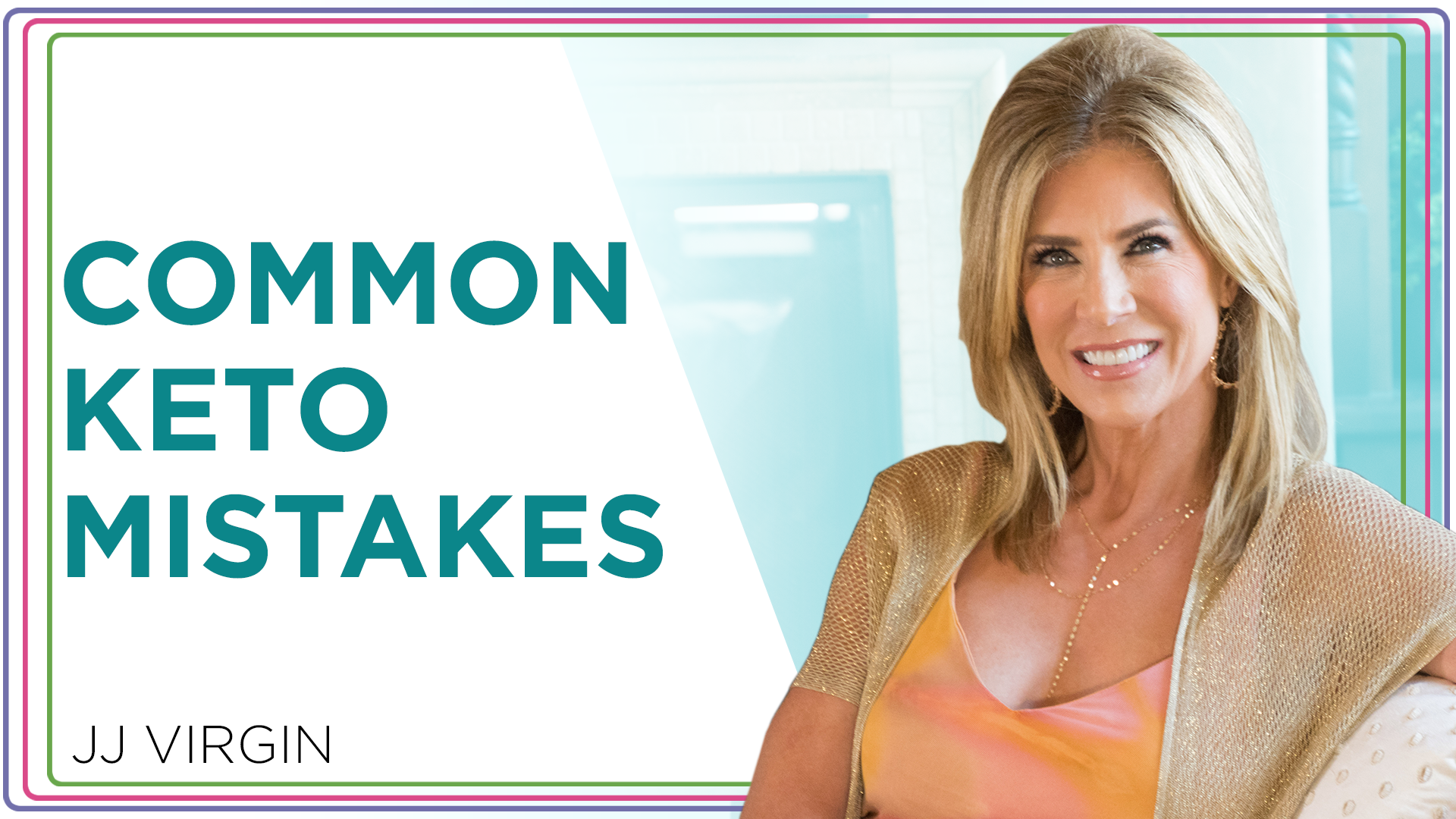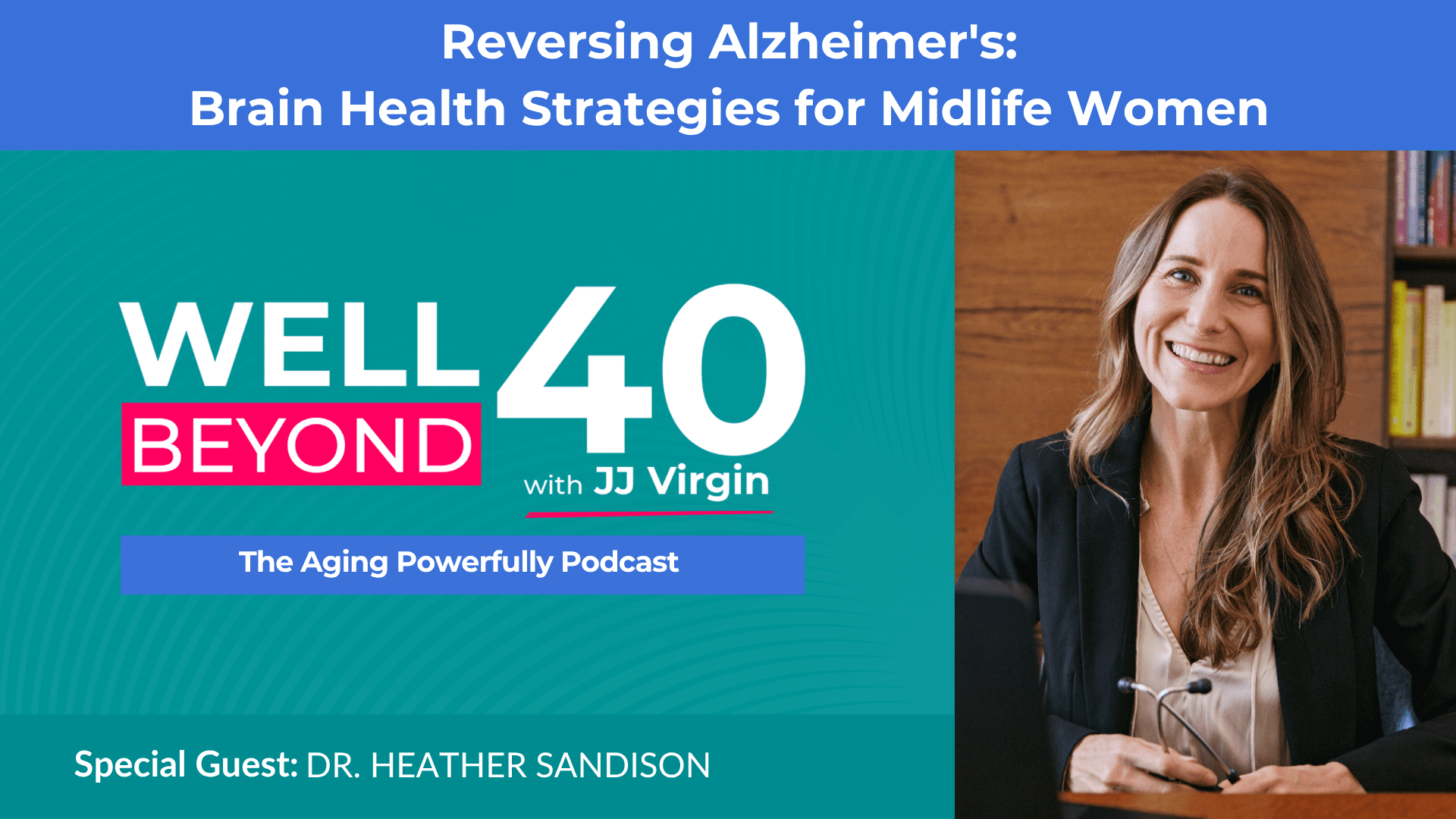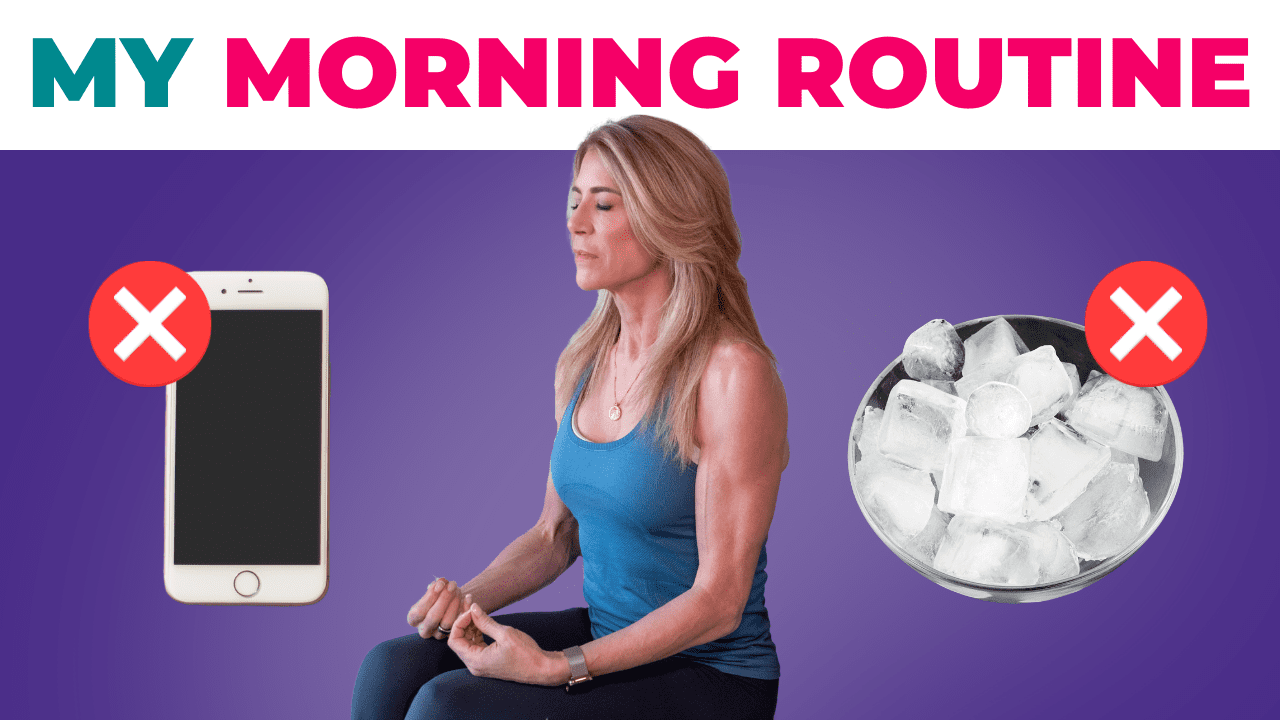Lose Weight, Feel Better + Get the Other Metabolic Benefits of a Keto Diet
Eat fat to burn fat… What could be more enticing? Ketogenic diets or “going keto” can help you lose weight and offer so many other benefits, but you want to make sure you’re not making these 3 common mistakes. You’ll learn why with keto foods, too much of a good thing can become a bad thing, the cycling trick that makes your body a multi-fuel burner (and lets you eat more carbs and variety on keto!), how metabolic flexibility can maximize your miles on keto, and how to break your sugar addiction without going cold turkey. Whether you’re a keto newbie or feel like you’re stuck on your plan, these strategies can help you break your plateau, choose the right keto foods, and get the most out of your keto plan.
Mentioned in this episode:
Watch the FULL VIDEO on JJ’s Youtube Channel
Find out if you’re a fat burner or a sugar burner
Fit more fiber into your plan with Extra Fiber
Learn more about metabolic flexibility in this article
Read more about breaking your sugar addiction with the Sugar Impact Diet book
ATHE_Transcript_Ep 420_YT 14
JJ Virgin: [00:00:00] Keto’s all the rage these days. And you want to know why? Because when it’s done right, it can really work well. It can help you get healthier. Feel better. But to get the most out of it, you have to make sure you’re doing it right. And that means you have to avoid the three most common mistakes. I see people make my videos are all about the things you can do to get and stay healthy and heal your metabolism, which is the first step in losing weight.
So if you want more like this click like and subscribe, so keto is a popular diet approach and it can do so much for your health. But it’s really easy to fall in the trap of the three common mistakes that will work against you. Be bad for your health and could even make you gain weight. Avoiding these landmines is easy.
If you know what to look out for first, a quick history lesson. Everyone keeps talking about keto as if it just happened. But keto isn’t exactly new keto as we know it has been around since the [00:01:00] 1920s, when it was first used as a way to help people with epileptic seizures. Now, the word is. For what it can do for your health and your weight now, Keto, and especially the way we’re going to be talking about cycling Keto, which I’ll explain in a little bit is really for everyone unless you’re pregnant or lactating.
When you’re eating keto, you’re eating lots of healthy fats, a good amount of protein. But very, very low carbs. The idea is that it helps you empty the sugar reserves in your body so that your body can’t use those as fuel. So instead you break down fat and get into a state called ketosis where you can use fat and ketones for energy.
That’s when you start to lose. And more importantly, reduce inflammation. But the key is that you have to be able to shift from being a sugar burner, to being a fat burner. And that’s one of the things we’re going to talk about now, there are a lot of other reasons other than weight loss to go. It helps you reduce your appetite.
It [00:02:00] helps you sleep better. It helps you increase your energy. It helps your brain heal. By the way, this is one of the things I used with my son when he had a traumatic brain injury and it can lower your blood pressure and cholesterol. It’s also great for controlling your blood sugar. For the record. I am not talking about dirty Keto, dirty Keto is code for letting in those cheap, highly processed foods.
You know, like the, a little pork rinds and diet sodas. We’re talking clean keto here. That’s the only way to go. And I know it can be hard to stick to, but if you’re putting in the work, you obviously want to make sure you’re getting the most out of it. So let’s make sure you don’t fall into these three super common mistakes, Ready?
Mistake number one, the first mistake is that yes, eating healthy, but you’re giving yourself a hall pass and you’re just eating too much. You know, the truth, too much healthy food. It’s unhealthy [00:03:00] just because you’ve swapped your mountain of pasta for some sirloin tips and asparagus doesn’t mean that you’re eating air.
You don’t just get a pass for a bigger plate. Portion size is still going to matter. Now, I’m sorry to rain on the parade, but there are some truths that we just can’t deny here. And one of them is that you eat more than you need to burn for energy, those extra calories. Got to go somewhere and if they’re not needed for building and repair, then they’re going to get stored as fat.
Besides that when you’re doing keto, you’re likely to be leaning heavy on animal protein. So try to mix up your sources of protein, and don’t always go for the red meat. Now. I love bacon, like the rest of us, but it shouldn’t be the star of your keto show. I want you to think some wild fish, get some pastured, pork and chicken.
Grassfed lamb. There’s lots of variety that you can work in. And if you’re working on eating more plant-based foods than some nuts and seeds of my plant-based protein powders [00:04:00] are great here too. So again, even if you’re eating healthy, the mantra is too much healthy food. I eat overeating is unhealthy.
Got it. All right. Now, overeating can also be really hard on your digestive system and mess up your sleep quality by lowering your deep sleep. The good news is Keto done. Also lowers your appetite. So overeating really shouldn’t be an issue. The only exception to keep your portions under control. And this is where I want you to go crazy is non-starchy vegetables.
Like let’s face it. It’s really hard to eat too much broccoli, cabbage and peppers. Right? So that can change fast though. Like you’re doing great with your broccoli. You’re doing your deep leafy greens and then you go pile on a ton of sauce. Okay. We gotta be careful there. So make sure that when you’re eating all those non-starchy vegetables that you’re keeping it clean, go and steam you’re using just a little extra Virgin olive oil or some fed [00:05:00] ghee.
All right. Mistake number two. So the second mistake people on keto make is staying on keto all the time and not cycling. You want to teach your body to run like a hybrid car where it can easily switch from burning carbs to burning fat, to burning ketones for. If you stick in ketosis all the time, you downshift your body’s ability to use carbs for fuel.
Now cycling prevents that from happening and means you can add in slightly higher carb days, which can be great for your higher intensity workout days. You can cycle in and out of keto for a few days or a few weeks. It really just depends on your goals and how you feel. Now, you may find that it works great for you to do week on and a week off, or you might find that feels best right on the edge of ketosis, where you’re eating low carb, but not super low carb, like true, true ketosis requires.
And can we be honest? That’s kind of a relief, isn’t it? Because when you’re staying strict with keto, you practically hit your carb [00:06:00] limit with too many carrots. And what joy is there in that? And odds are you going to cheat? And when you cheat, you’re going to go off the rails. And remember you just taught your body, how not to handle carbs.
Well, again, why we want to cycle when you cycle, you can pull in more carbs, but take it easy. That does not mean go spin out, out of control here and undo all of the work that you did stick to healthier carbs in moderate amounts, things like wild rice and winter squashes and berries, or my favorite. I take a barely ripe green banana.
I freeze them like that and put half of that into my smoothie in the mornings or a cold boiled potato makes some potatoes, boil them, keep them in the fridge. Those are great because of that resistant starch that can actually help you burn fat and feed the good microbiome. Now, when you add in a few more carbs, let’s say with any of those things or legumes, you’re also upping your fiber.
And that’s one of the challenges on keto. Usually on keto. Fiber can be a little bit low and getting more [00:07:00] fiber is great for your digestion, your appetite, and most importantly, your gut microbiome cycling is also really good for athletes, or if you’re active or if you want to gain some muscle and not just lose fat from ketosis.
All right. On the days that you’re cycling in more carbs, make sure you pay attention to how you feel if you feel better. And it doesn’t sabotage your fat loss goal, stick to a cycling schedule. Keto is great for a short time to break through a weight loss plateau, but ultimately you want to figure out where you live best long-term and how much you want to cycle in and out of it.
And that brings us to common mistake. Number three, the third mistake people make on keto is not preparing your body. Meaning not getting metabolically flexible first. Keto is working when you burn fat and ketones for fuel instead of sugar. If you want your body to dip into your fat for fuel, you have to shift away from burning sugar as your primary fuel [00:08:00] source as burning fat helps your energy and your appetite too, as well as helps you lose weight.
What’s cool is when you are a fat burner, you’ve made that shift from burning sugar as your primary fuel to being able to burn fat as well. You can easily go four to six hours between meals and you don’t get hit with the crazy cravings. You also can lose fat pretty easily, especially off your waist.
And you’ll just have more steady sustained energy all day long. I mean, that sounds like something you want, doesn’t it. But if your primary source of fuel is. Your body has no reason to access your stored body fat for energy. All right. So how do you know if you’re a sugar burner or a fat burner? If you lose weight, but you don’t lose weight around your waist, that’s a sign of a sugar burner.
If you can’t go more than two to three hours without eating. That’s another sign of a sugar burner. If you hardly ever [00:09:00] feel full and satisfied after you eat, or you feel like you just got to snack all the time to keep your energy up, or you go a couple hours over your normal eating time and you’re hangry, or you crave carbs and sugar, or you just can’t seem to lose fat off your waist no matter what you do.
All of those. You guessed it. Those are signs that you are a sugar burner and you can’t burn off stored fat and ketones for fuel. Now, if you want to be sure, take my quiz at jjvirgin.com/sugarquiz. I’ll put it in the links below. So ideally before you jump into. You won’t be stuck as a sugar burner and you’ll already gone through the process that you need to go through to get metabolically flexible.
So what do I mean? Well, just like exercise. When you exercise, you need to cross train, you do some walking. I say moving more like walking after a meal, you’ll do some high intensity interval training or burst training. You do some resistance training. It’s [00:10:00] just the same with your diet. You want to cross train your diet to be metabolically flexible.
So you can switch between burning sugar and burning fat and burning ketones. Whenever your body needs the different. Just like during exercise, you know, if you’re doing high intensity interval training, you are going to be using more of your glycogen stores, your sugar for exercise. First fuel source, same with resistance training.
But if you’re doing some restorative yoga, you’re going for a long walk, you better be able to shift into those fat reserves so that you’ll be able to sustain it longer. So you cross train your. By not eating the same amount of calories or the same macros all the time. Just like we’re mixing up cycling in and out of keto, you mix up the protein, carbs and fat that you have, because remember.
Your body is not a bank account. It’s a chemistry lab. Our ancestors were metabolically flexible. They had to be to survive the famines, to be able to make it through the winters. We are naturally designed to do [00:11:00] this. Our bodies can handle when we cycle fats, our bodies can handle when we raise and lower carbs, our bodies can handle when we miss a meal.
The key is to get to know your body and tune in to how it responds and how it changes with your diet so that you can really design the best diet for you. Now, the good news is if you’re a sugar burner, you can become metabolically flexible and have even more success on keto. And I talk a lot about this in my sugar impact diet book, but don’t try to fix it by cutting out the sugar and carbs cold Turkey.
That’s one of the things I talk about as like the biggest mistake people do when they try to get rid of their sugar cravings. If you do that and you try to force your body to use fat when it’s not ready to yet, it can only lead to cravings and withdrawal. And by the way, set you up to fail, that gets you into that whole yo-yo dieting cycle, which makes me crazy on my watch.
There’s no more dieting as a hobby, right. I promise. You’re going to feel [00:12:00] lousy. If you try that, you’re going to crater your energy. You’re going to have brain fog and basically feel like you’re starving because really you are, and then you’re going to cave and you know, you’re going to do? You’re going to crawl right back over to the sugar.
So to do it right, you need to gradually lower your sugar impact by eliminating the most damaging sugars. I call those high sugar impact foods and replacing them with lower sugar impact, healthier options. Now, for help on that transition, check out my sugar impact diet book. It walks you through this process and by the way, I can get you there in
two weeks shifting you from being a sugar burner to a fat burner and getting you metabolically flexible and ready for Keto now, if you found this video helpful, don’t forget to hit like and subscribe to keep more like it coming up next, check out my video on one of the major reasons people in the blue zones live a long, healthy life.
It’s something you can do too! See you there[00:13:00]
for more info on this and other health topics I cover or to rate and review find me on Instagram, Facebook and my website, JJvirgin.com. And don’t forget to subscribe to my show. So you won’t miss a single episode. Go to subscribetojj.com. Thanks again for being with me this week. .

 Subscribe to our show
Subscribe to our show 




